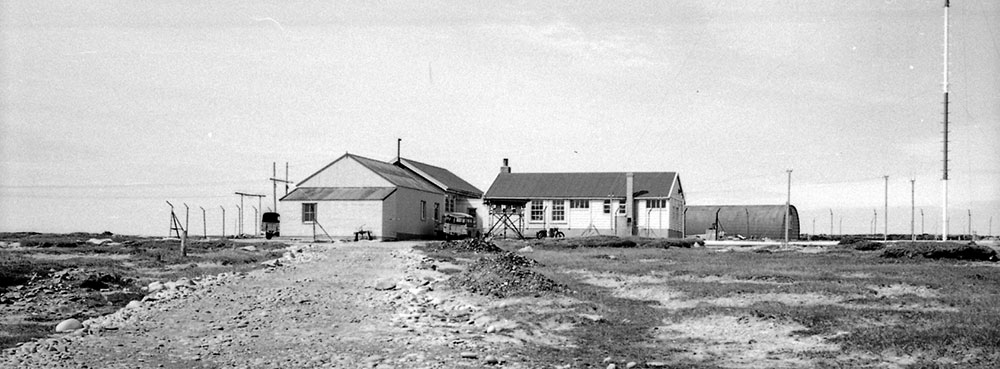History of telecommunications
Telephones first came to the Falklands in 1880 when Mr Boyson, a manager, installed them at the Falkland Islands Company. In 1897 the Government finally installed one at Cape Pembroke with a single line (7 miles) to Stanley Police Station. This was to improve response and rescue chances for ships in distress and making for shelter in Port William. The police maintained the line. A Telephone Exchange was opened in Stanley in 1906, a small exchange with a silent cabinet. The new telephone system, consisting of a 30 line board with metallic returns was installed in Stanley. New poles, insulators, wire, and several new wall sets were provided. By 1912 all Government buildings, businesses and some private houses had telephone lines. This was charged at £8 per year. The public could make calls from a public call room at the back of the exchange buying three minutes for 2d and five minutes long distance for 6d.
A line to Darwin was installed by 1907 (49.5 miles). This line was jointly owned by the Falkland Islands Company and the Government and maintained by the FIC. The line was purely for the use of business homes but the public could make calls at certain times. Breakages were frequent, 64 having occurred during the year to November 1908 and were blamed upon the Upland Goose, ‘the wire being unable to withstand the impact of that bird’. Stronger, thicker wire was used to replace where the breakages always occurred at the insulators (Colonial Report). Soon lines to other farms were erected on East Falkland, supervised by Mr Homer the electrical engineer. Lines between farms were privately owned.
A new Marconi wireless station was built between March and August 1912. It was situated on top of a ridge at the East end of Murray Heights, ‘Wireless Ridge’ about two miles from Stanley. The Governor opened the station on September 24th. The wireless installation was supplied by the Marconi Wireless Telegraph Company Limited, London, and consisted of a 5KW set, a low frequency alternator, and rotary spark discharger, the prime mover being a 15 BHP oil engine. Two 220 feet masts were erected. Regular communication, within an operating range of 1000 miles, was possible, atmospheric conditions permitting. The new wireless station came into its own shortly after it opened when on the night of 12th November the ‘Oravia’ with 412 people on board, ran ashore on ‘Billy Rock’ off Cape Pembroke. News of the disaster was quickly reported via the station and rescue organised resulting in no loss of life. Further a message was sent to the S.S. ‘Hauanchaco’ to call at Stanley on the 18th and take most of the passengers to Punta Arenas.
In June 1917, over on West Falklands, W. H. Luxton of Chartres wrote to J. A. Wilson, Stipendary Magistrate at Fox Bay and proposed to erect a telephone line between Chartres and one of the Fox Bay Government Buildings. Wilson saw no objection and wrote that the line would be the central artery of a telephonic system which would later link them to Port Howard and Hill Cove. He also wrote ‘The Farmers are seriously contemplating this. Later date Port Stephens Link. A great advance will thus be attained as regards the internal communications on the West Falkland Islands, and in recommending the Fox Bay Centre to be under the charge of the residential official, I strongly feel that this would be an additional advantage both to the Government and Public and more especially in view of the proposed erection of the wireless installation at this place.’
A Wireless Station, linked to the new Marconi Wireless Station by Stanley, was built on the Government Station at Fox Bay East by 1918. Telegrams could be sent or received via Morse Code twice per day. With the new network of telephone lines linking the West Farms the whole of the West could communicate with Stanley. Goring House close to the river crossing at Little Chartres, and a crossroads for travellers became the ‘telephone exchange’ where the central artery of the Fox Bay - Chartres line of the telephonic system linked to Port Howard and Hill Cove. One ring or one turn of the old telephone handle would be answered by Mrs Macaskill who would put you through to the required settlement and vice versa. Six turns would get the Government Wireless Station at Fox Bay and five turns the Doctor at Fox Bay. There was little privacy on the line as anyone with a phone could 'listen in'. Telephone lines were frequently 'down' or broken but still served the islands well and were still in use until 1982.
Radio Telephones 'R/T's'
In the 1950's the Government introduced an internal radio/ telephonecommunication service to link the camp to Stanley. Every settlement including small islands with only one family had an R/T, a network of around 40 transmitters.
The main control centre was in Stanley and anyone could call in with telegrams, medical problems, book flights, order stores or even to speak to someone. Various stations, including Fox Bay gave regular weather reports for the air service and meteorological station. The R/T was also used between stations and islands for conversations and the West Doctor could be called for advice, rather public as everyone was 'tuned in' but it worked and no one minded!The R/T system was really important to the camp and lasted until after the 1982 conflict. |

 Photograph Charles Maddocks
Photograph Charles Maddocks